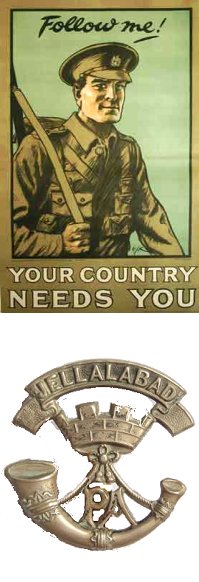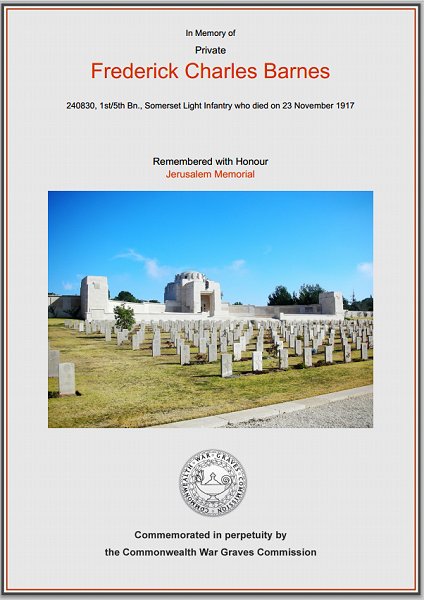yeovil at War
Frederick Charles barnes
Missing in action outside Jerusalem
Frederick Charles Barnes, known as Fred, was the youngest son, and second from youngest child, of William Barnes and his wife, Ann. Frederick was born in Yeovil in 1893. In the 1901 census the family were living at 43 Kiddles Lane. William gave his occupation as a Leather Glove Cutter and he and Ann were living there with five of their children including 8-year old Frederick Charles.
In the 1911 census the family were living at 75 Earle Street. William and Ann Barnes had been married for 39 years and had had nine children of whom two died in infancy. William gave his occupation as Glove Factory Foremen and Fred and his older brother William were both listed as Glove Cutters.
 In
1914 21-year old
Fred enlisted in
the Army at
Yeovil and
became a Private
(Serial No
240830) in the
1st/5th
Battalion of the
Somerset Light
Infantry.
In
1914 21-year old
Fred enlisted in
the Army at
Yeovil and
became a Private
(Serial No
240830) in the
1st/5th
Battalion of the
Somerset Light
Infantry.
The 1st/5th Battalion was a Territorial Battalion formed on 4 August 1914 at the County Territorial Hall, Taunton as part of the South-Western Brigade, Wessex Division. It was initially stationed at Plymouth for a few days and then proceeded to Salisbury Plain. On 9 October 1914 the Battalion, including Fred Barnes, sailed from Southampton and arrived at Bombay, India, on 9 November 1914. The battalion remained at Jubbulpore until December, when it proceeded to Ambala. Strenuous training began almost immediately and continued almost for the next year.
In May 1916 a large draft of nine officers and 449 other ranks arrived from England. The battalion was temporarily divided during the ensuing hot weather with some companies going to Chakrata and the remainder to Meerut.
The following
months were
mainly occupied
in training the
draft but even
in the hills
little was done
beyond this
owing to the
exceptionally
wet season. The
Battalion was
reunited in
October at
Meerut. On 26
April 1917 17
officers and 838
other ranks of
the Battalion
sailed on HMT Chakdara from
Bombay, landing
at Suez, Egypt,
on 11 May 1917,
becoming part of
233rd Brigade,
75th Division -
part of the
Egyptian
Expeditionary
Force in
Palestine.
Having spent an
uneventful two
and a half years
in India it was
now intended
that the 1st/5th
Battalion was to
become involved
in the attack on
Gaza which had
been ordered to
take place on
the morning of 2
November 1917
although 1st/5th
Battalion of the
Somerset Light
Infantry were
ultimately not
employed in the
attack.
The Regimental History of the Somerset Light Infantry records "Several weeks training at El Arish and Rafa, where long route marches through the burning desert fitted the battalion for the part it was to play in the near future, followed on 28 August Nos 1 and 2 Companies of the Battalion went into the trenches in the Sheikh Abbas area, south of Gaza, and were attached to the Argyll & Sutherland Highlanders for preliminary instruction in trench warfare.
On 12 September 1917 the Battalion took over the Apex right sub-sector of the Sheikh Abbas sector, three Companies in the front line and one in reserve. The front line taken over was approximately 2,000 yards in length. The remainder of September was uneventful, but the final entry in the Battalion Diary is of interest :-
"The health of the Battalion was not quite so good as previous month. Septic sores were very prevalent and 16 cases of dysentery occurred. The enemy's lines opposite Apex Right are nowhere near rather than 2,000 yards to our front-line trenches and the most important work done is by the night patrols. A considerable amount of work has been done on the trenches, 18 new dugouts have been constructed and additional trenches are being dug in our right subsector."
Following the attack on Gaza, the 1st/5th Battalion were next engaged in the Battle of Nebi Samwil, part of the Jerusalem Operations, from 17 to 24 November 1917. General Allenby had decided to attack the Turkish Seventh Army and occupied Jerusalem. This necessitated an advance through the difficult country of Judaea and Allenby's plan of attack was to move through the Judaean hills and break out onto the main Jerusalem-Nablus road, cutting off the Turks in Jerusalem. On 14 November the three brigades of the 75th Division were deployed, with the 1st/5th Somersets occupying the ridges west of El Kesman. They moved on 16 November to take up a line on a range of low, stony hills to the east of Junction Station and remained in this position throughout the 17th, when the operations began. The infantry advance began on 19 November with the 1st/5th Somersets concentrating on the Jerusalem Road, north of Junction station and then proceeding forward. The attack on Enab was carried out by the 1st/5th Somersets in front. According to the Regimental History "There was heavy driving rain as the troops moved forward and mist covered the battlefield, but with great dash the attacking waves advanced and completely drove the Turks from their positions in front of Enab.
For two hours during the early morning of 21 November the village of Enab was shelled heavily by the Turks and, owing to the congested state of the village -packed with troops and animals - casualties were heavy. On 23 November 1917 the 1st/5th Somersets of the 233rd Brigade had again become involved in stiff fighting with the enemy who was posted in strong positions at Nebi Samwil." It was during this fire-fight that Private Frederick Barnes was killed, but reported missing. He was aged 24.
Other Yeovil men killed in this battle were Frederick Wickstead, Harry Holland, Wilfred Purchase, Thomas Luxton and Edward Bell.
On 20 September 1918, the Western Gazette reported "Mr William Barnes of Earle Street, has received news that his second son, Private Fred Barnes, who was reported missing on 23rd November 1917, is now presumed to have been killed on that date. Private Barnes who went to India with the Territorials in 1914, was later transferred to the Palestine Front."
Frederick Barnes is commemorated on Panel 17 of the Jerusalem Memorial, and his name is recorded on the War Memorial in the Borough - albeit as Barnes, F rather than the correct Barnes, FC.
gallery

The Commonwealth War Graves Commission certificate in memory of Fred Barnes.